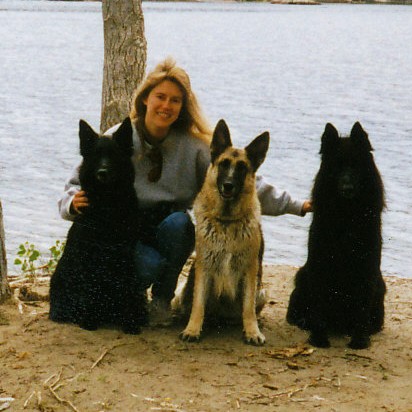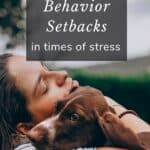When we’re stressed, it can affect our dogs’ sense of security and stability, and as a consequence, their reactions. If you have a dog with behavior issues, there are some simple steps you can take to minimize behavior setbacks during times of stress and uncertainty.
An email from a flower essence client reminded me that we need to be especially careful with our dogs in times of stress.
This lady’s new rescue dog had not been getting along with the other dog at home. They had been doing very well for the past few weeks with a couple of my “Getting Along Better with Others” flower essence formulas, plus careful management while the dogs’ relationship improved. But a few days ago, another big fight erupted.
This is really not unexpected. When we’re stressed, it can affect our dogs’ sense of security and stability, and therefore, their reactions. Stress can also lead us to get impatient with our dogs, or blow off bad behavior as being too much to deal with. Even worse for the dog, we may switch back and forth between the two.
However it comes out, our stress can have consequences for our dogs’ behavior.
Even for those of us dealing well with the uncertainty, a simple change in our dog’s routine can have unexpected results. For some dogs, even an out-of-the-ordinary amount of cuddles and affection can be a problem.
That’s not meant to stress you out further 🙂
Just to point out that, if you have a dog or dogs with some behavior issues, or even a tendency toward them, there are some things worth keeping in mind.
Structure may be the most generous gift you can give your dog
It’s tempting to think that we can “make up” all the extra stress, or lack of attention, etc., with additional affection and “love on the dog” time. (Personal note : I am really bad at this!)
And this may be absolutely fine in a balanced, secure dog. But in a dog that is insecure, or one that’s pushy and likely to test boundaries, or that has attachment issues, it can actually backfire on you.
Definitely love on your dog, and take comfort in the joy of having a dog. But try to balance this out with structured training sessions with your pup. Set aside two or three 5 minute sessions each day to teach something new, or practice (or improve) some behavior already taught.
This will give your dog something predictable to look forward to, will help him see you as a good leader, can enhance your training (and overall) relationship, and is a great boredom-buster to boot!
Some backsliding in dog behavior is normal
If your dog had been making progress before whatever major or minor Stress Event came along, realize she may very well backslide some.
While it is obviously better if she doesn’t backslide, if she does, it truly is not something to stress over.
If she had improved before, she can go back to that level of improvement if she backslides. (For a detailed look at recovering from training setbacks, see my training article on Train2Behave.com, Overcoming Setbacks in Dog Training.)
Steps to minimize behavior backsliding in your dog
Keep up your regular schedule and routine, as much as possible
This is more important for some dogs than others, but all will benefit from a predictable eating, sleeping, bathroom, and training schedule. If your dog has separation issues, be sure you continue to follow some version of your regular away-from-home routine even when you’re home.
Look for ways to add structure to your routine
For easily stressed dogs, and dogs very sensitive to your emotions, structure is crucial in times of stress. There’s a reason it’s called “structure”, after all – it adds stability! That’s good for our dogs (and all of us), especially in times of stress or uncertainty.
What’s meant by structure? Structure is really a framework for how you live with your dog. It should be tailored to what fits for your life, your personality, and your dog’s temperament and abilities.
In my home, it means the dogs have to go out and wait out of the kitchen when I’m preparing food. If I eat on the couch (and I usually do), any dog lying there needs to vacate the couch and go lie down at a distance.
Dogs aren’t allowed to blast through doors.
My teenage pup, like most dogs his age, needs frequent work on thinking before acting. With him, I generally require that he gives me eye contact before being allowed to go out, come in, or other things he wants to do. Stuff like that.
Think about what is useful and practical in your home, and starting with things your dog already knows (like sit, lie down, wait, stay, come – whatever she has under her belt), add some structure here and there.
It’s good for self control, good for confidence building, good brainwork, and good for leadership.
Check in on your dog’s stress levels
Note I do not say “obsess over your dog’s stress levels” :-).
In times of stress, it’s easy for early signs of canine stress to slip right by our notice. So, periodically try to pull away from keeping up with “what’s going on” and observe your dog.
If you catch any changes (i.e. regression) quickly, it will be less work to fix it later.
Use management techniques to improve safety and reliability
There’s no shame in falling back on management techniques to keep your dog from backsliding! It’s actually a great idea anytime you’re extra busy, stressed, or can’t set aside an adequate amount of attention to pay to your dog.
Some ideas to get you thinking:
- Baby gates (or any convenient barrier) can be used to make sure two dogs that don’t always get along can be separated at trouble times.
- Have dogs that get possessive over food or toys? This might be a good time to separate them, even if only by tethering, when getting tasty treats or chews.
- Live with a dog that guards the bed or couch, or certain areas of the room? Or maybe just refuses to move when asked? Block off those areas for now, if practical. If not, having the dog drag a light 6 ft line around the house – when supervised – is an excellent management and training technique. (Pick up the far end of the line, turn away from the dog and walk, until the dog is moved away from the area. Follow up with some brief praise and you’re done.)
- Does your dog react to elevated stress by barking at every noise and movement? Find some pleasant white noise on YouTube or your phone, and turn it on at a good volume. This will help mask the sound of the neighbors. Close curtains or block off your dog’s access to windows that look onto outside activity. And give your dog something better to focus on, like a stuffed chew toy or bone.
Basically, if you had any management techniques in place that helped earlier, consider going back to those in high stress times (this or any other).
Consider increasing the flower essences
Finally, for dogs on flower essences like Rescue Remedy or other flower essence blends, consider bumping up the number of doses of your dog’s formula. In times of stress, it may take more frequent doses to keep up the level of improvement you’ve been seeing.
You don’t need more drops or sprays per dose, but an extra dose or two per day can be very helpful.

Julie Cantrell BSc is a professional dog trainer and canine behavior consultant who’s logged many thousands of hours training dogs and teaching owners since 1990. Flower essences have been part of her work with canine behavior since 1994. (bio)








